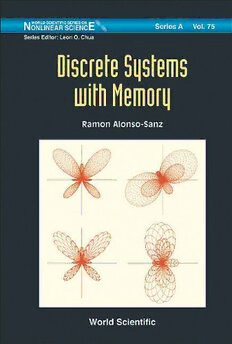
Discrete Systems with Memory (World Scientific Series on Nonlinear Science, Series a) PDF
478 Pages·2011·37.931 MB·English
Most books are stored in the elastic cloud where traffic is expensive. For this reason, we have a limit on daily download.
Preview Discrete Systems with Memory (World Scientific Series on Nonlinear Science, Series a)
Description:
Memory is a universal function of organized matter. What is the mathematics of memory? How does memory affect the space-time behaviour of spatially extended systems? Does memory increase complexity? This book provides answers to these questions. It focuses on the study of spatially extended systems, i.e., cellular automata and other related discrete complex systems. Thus, arrays of locally connected finite state machines, or cells, update their states simultaneously, in discrete time, by the same transition rule. The classical dynamics in these systems is Markovian : only the actual configuration is taken into account to generate the next one. Generalizing the conventional view on spatially extended discrete dynamical systems evolution by allowing cells (or nodes) to be featured by some trait state computed as a function of its own previous state-values, the transition maps of the classical systems are kept unaltered, so that the effect of memory can be easily traced. The book demonstrates that discrete dynamical systems with memory are not only priceless tools for modeling natural phenomena but unique mathematical and aesthetic objects. Read more... Machine generated contents note: 1. Cellular Automata and memory -- 1.1. Cellular Automata -- 1.2. Memory -- Disclaimer -- 2. Average type memory -- 2.1. Average memory -- 2.2. Two-dimensional lattices -- 2.2.1. Totalistic rules -- 2.2.2. LIFE -- 2.3. One-dimensional layers -- 2.3.1. Elementary rules -- 2.3.2. Nearest and next-nearest neighbors -- 3. Other memories -- 3.1. Average-like memory -- 3.2. Limited trailing memory -- 3.3. Majority of the last three state memory -- 3.4. Elementary rules as memory -- 3.5. Minimal memory -- 4. Asynchrony and probabilistic rules -- 4.1. Asynchrony -- 4.2. Probabilistic rules -- 5. Cycles and random sequences -- 5.1. Cycles -- 5.2. Random number generation by CA -- 6. Three state automata -- 6.1. Totalistic rules -- 6.2. Excitable systems -- 7. Reversible dynamics -- 7.1. Characterization -- 7.2. Reversible rules with memory -- 8. Block cellular automata -- 8.1. Characterization -- 8.2. Density classification task. 9. Structurally dynamic systems -- 9.1. Introduction -- 9.1.1. Reversible SDCA -- 9.2. SDCA with memory -- 9.2.1. Two state SDCA with memory -- 9.2.2. Three state SDCA -- 10. Boolean networks -- 10.1. Automata on networks -- 10.2. Boolean networks -- 10.3. Automata on proximity graphs -- 11. Coupled layers -- 11.1. Coupled cellular automata -- 11.2. Coupled Boolean networks -- 12. Continuous state variable -- 12.1. Continuous-valued automata -- 12.2. Finite difference equations -- 12.2.1. One-dimensional maps -- 12.2.2. Two-dimensional maps -- 12.3. Plane curves -- 12.4. Stochastic processes -- 13. Spatial games -- 13.1. The prisoner's dilemma -- 13.2. Degrees of cooperation and strategies -- 13.3. The structurally dynamic PD (SDPD) -- 13.4. Pavlov versus anti-Pavlov (PAP) in the PD -- 13.5. Other spatial games -- Appendices -- Appendix A Average memory starting at random -- Appendix B Dynamic with short-term memory -- Appendix C Heterogeneous and coupled networks -- Appendix D Continuous state variable -- Appendix E Spatial games
See more
The list of books you might like
Most books are stored in the elastic cloud where traffic is expensive. For this reason, we have a limit on daily download.
